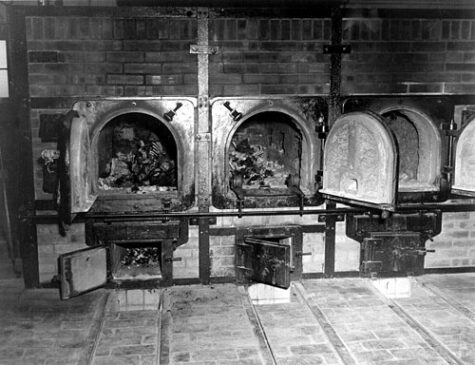How persistent are cultural traits? Studies of Nazi voting in 1933 show that the roots of Nazi antisemitism and the events from 1928-45 – and later – mirror the pogroms carried out in the mid-14th century.

When the Black Death hit Europe in 1348-49, violent attacks were staged against a vast number of Jewish communities, leading to horrifying pogroms. Consequently, Jews were burned and killed in a terrifying number of towns and cities all over Germany. In 2012, Voigtlander and Voth demonstrated that the same places that witnessed violent attacks on Jews during the 14th-century plague also exhibited more anti-Semitic attitudes over half a millennium later. In simple terms, people residing in towns infested with pogroms in the 14th century engaged in more anti-Semitic violence in the 1920s, were more likely to vote for the Nazi Party before 1930, wrote more letters to anti-Semitic newspapers, organized more deportations of Jews in the 1930s, and saw more attacks on synagogues during the Crystal Night (Reichskristallnacht) in 1938.
Notably, this violent hatred of Jews persisted despite the fact that Jews disappeared from many towns and cities for centuries. For instance, the Jews in Erfurt experienced several pogroms in 1221 and 1349. Although they returned in 1354, they were expelled after 1446 and did not return until after the Napoleonic Wars. Yet, Erfurt once again became home to rampant antisemitism in the 1930s, leading to mass migration and deportation. After the war, only 15 Jews returned.
This statistically significant correlation was then compared against other possible explanations, such as the economy, geography, and low mobility. Neither of these factors appeared to have statistically significant correlations. However, the authors did find “partial support for Montesquieu’s famous argument that trade encourages ‘civility’.” Hanseatic cities with a tradition of long-distance trade did not exhibit persistence of anti-Semitism. Many studies have questioned whether the rise of the Nazi Party should be interpreted as a direct consequence of growing, broad-based anti-Semitism in the Weimar Republic. Vogtländer’s and Voth’s findings did not support this interpretation. While they still found a clear effect of medieval pogroms on the Nazi vote in 1928 and a weaker one in 1930, this link disappeared as the party’s mass appeal grew.
In 2015, this study was followed up with an exploration of Nazi indoctrination between 1933 and 1945 and its connection to antisemitic waves in Germany in 1996 and 2006. In this work, Voigtländer and Voth demonstrated how attempts at “modifying public opinion” through advertising, schooling, and general “brainwashing” had a tremendous effect. They also showed that Nazi schooling was the most effective, not radio or cinema propaganda. Additionally, they demonstrated that where schools could tap into pre-existing prejudices among the pupils and their parents, schooling had the most profound consequences. In simple terms, if you were born between 1930 and 1940, you were three times more likely than your grandchildren to become and remain antisemitic. The NSDAP recognized more than any other political party that “those who control the children own the future,” they wrote.
Critique
Arguably, Voigtländer and Voth documented an exceptional geographic persistence in patterns of antisemitism between 1349 and 1945.
However, in 2019, Becker and Pascali sought to broaden this perspective by noting that the Protestant Reformation in 1517 appeared to be a watershed moment for Jewish life in Germany. Until the Reformation, Jews had been somewhat tolerated as the only moneylenders in the market. However, after the Reformation, widespread competition in the moneylending business led to widespread antisemitism. However, this explanation suffers from the fact that the towns organized in the Hanseatic League and Scandinavia did not engage in antisemitism on par with the German Reformation states. This is despite the fact that while Scandinavia was distinctly ruled by staunch Lutheran monarchs and in the grip of orthodox Lutheran national churches, the same antisemitism did not take root there in the same manner as in, for instance, Lutheran Thüringen and Sachsen-Anhalt. The first privileged Jewish community was founded in Glückstadt in 1619, and it was followed by Fredericia in Jutland in 1682. In 1684, the first Danish Ashkenazi community was founded in Copenhagen.
Perhaps the fact that Jews were neighbors here explains the lack of antisemitic fervor still plaguing Germany today?
SOURCES:
Persecution Perpetuated: The Medieval Origin of Anti-Semitic Violence in Nazi Germany
By Nico Voigtläender and Hans-Joachim Voth
The Quarterly Journal of Economics, Volume 127, Issue 3, August 2012, Pages 1339–1392
Nazi Indoctrination and Anti-Semitic Beliefs in Germany.
Voigtländer, Nico, and Hans-Joachim Voth.
Proceedings of the National Academy of Sciences of the United States of America (2015) 112 (26): 7931–36.
Religion, Division of Labor, and Conflict: Anti-semitism in Germany over 600 Years
Sascha O. Becker and Luigi Pascali
In AMERICAN ECONOMIC REVIEW
VOL. 109, NO. 5, MAY 2019
(pp. 1764-1804)
READ MORE:
